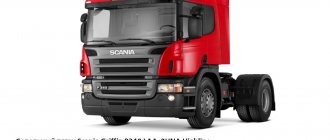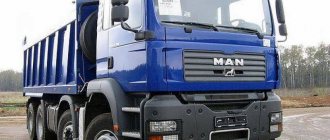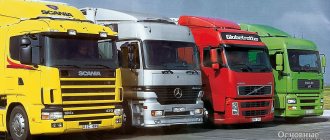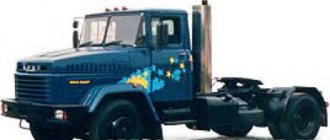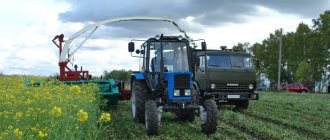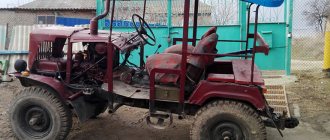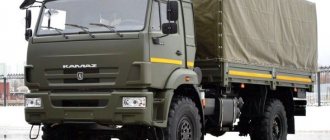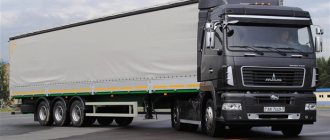Truck tractor: design features
Automotive tractors are divided into several categories, one of which is the truck tractor. It is distinguished by the presence on the car of a special coupling unit - a saddle, which gave the name to the car.
This connecting saddle assembly of the vehicle is a load-bearing plate with a slot for the king pin. The fifth wheel coupling has several degrees of freedom in the longitudinal and transverse directions.
This connection of a tractor and a trailer, or rather a semi-trailer, allows you to redistribute part of the load on the vehicle, thereby increasing the permissible weight of the transported goods.
In Europe, a cabless truck is mainly used as a fifth wheel, while in the USA, a bonnet truck is used. Therefore, in the countries of the post-Soviet space they were divided into the American type and the European one.
American type truck tractors
American tractors have greater passive safety due to the fact that the engine compartment is moved forward. Access to the engine in cars with a hood arrangement is more convenient. And the American cabin is much more comfortable.
However, the disadvantages include the large length of the tractor and, as a result, a larger turning radius. This makes it difficult to maneuver a truck with a semi-trailer in a confined urban space, but gives comfort to the driver on long intercity trips.
The tractor itself is usually three-axle with two rear drive axles. By moving the engine behind the front axle, the weight distribution of the vehicle becomes more correct and in such tractors there is no need to use a sloth - a lifting axle. In addition, the machines have the ability to move the fifth wheel coupling for attaching the semi-trailer along the longitudinal axis, thereby changing the distribution of the weight of the load.
European tractor unit
In the Old World, trucks with a hoodless design are most in demand. Their engine is located under the cab, which is not so convenient for maintenance. In addition, when the cabin is raised, loose items from the sleeping bag will fly forward. And you won’t be able to climb into an overturned cabin either.
However, the advantages of the cabover truck layout are its maneuverability, better visibility, and a short wheelbase that allows you to hitch a longer semi-trailer.
Basically, European-type tractors are produced with two or three axles. Often one of the rear axles is lifted to reduce total cost of ownership and increase payload.
Saddlebacks with four axles are less common. They are mainly used for special transport and in the military.
On two axes. Truck tractors
Buying a tractor unit is not an easy task. On the one hand, today the choice is greater than ever. But there are no queues for equipment, such as were observed in the pre-crisis years, and are not expected in the near future. Competition in the market is fierce; equipment manufacturers not only reduce prices in order to increase sales, but also do everything possible to ensure that popular, popular truck models have the maximum number of options necessary and in demand by drivers. For example, today transport companies are taking a more balanced approach to choosing a tractor cab. Savings on options with a low roof are not relevant, especially if the car operates on a “long shoulder” and the driver often has to spend the night in the car.
Taking this circumstance into account, commercial vehicle sellers, working in close cooperation with automakers and official representative offices, are developing programs in which tractors with medium and high cabs and “sleeping bags” mandatory for long-distance drivers are offered at an attractive price - that is, they do everything so that the client does not went to a competitor. The same applies to the power line components of the tracks. So, in order to attract attention to its truck, an automaker can install a more powerful engine on the vehicle and at the same time slightly increase the selling price of the tractor. The same applies to gearboxes. Relatively cheap mechanics are being replaced by electronically controlled gearboxes. At the same time, the increase in the cost of a complete tractor will remain within reason.
Moreover, today you can evaluate the benefits of an optimally selected power line directly at work. Equipment sellers (meaning large trading companies with a wide network of showrooms and service centers) provide their customers with cars for so-called test operation. Within a week, or even a whole month (!), the carrier has the opportunity to test the machine in action by placing the tractor on the line. Of course, this is done subject to a number of conditions that are specified in the car transfer agreement, and, of course, not for free. The contract also establishes the responsibility of the parties in the event of an incident or force majeure. Trial operation allows the transport company, first of all, to determine the real fuel consumption on a particular route and compare it with what is demonstrated by the trucks already in the fleet. Thus, the carrier has the opportunity to calculate the reduction in fuel costs. And this indicator is one of the most significant in the list of transportation costs. It goes without saying that in order to obtain reliable data, trucks taken for test operation, as we mentioned above, must operate on established routes. This is the only way to obtain objective figures.
In addition to fuel consumption, the carrier must also evaluate the service network of the truck brand he likes. This is one of the reasons why even a very attractively priced car can be crossed off the list of candidates for purchase. If you have to drive it far away to repair and maintain a tractor, no one will need it. A downtime machine will cost more, and a lost client is also a blow to the company’s reputation.
When assessing the brand’s service network and the location of branded service stations relative to the carrier’s fleet, one should also take into account such parameters as the cost of spare parts and the frequency of maintenance. For example, if a dealer sets the maintenance interval not at 60, but at, say, 40 thousand kilometers, this means that vehicle maintenance costs will increase by at least a third. At the same time, reducing the maintenance interval can be presented as a benefit - the operating conditions of cars in Russia are much more stringent than in Europe. And the quality of the fuel comes first as an undeniable argument. However, let’s not lie - in recent years the fuel market in Russia, including in terms of fuel quality, has changed significantly, of course, for the better. Therefore, it is no longer possible to say that we have a problem with diesel fuel. Moreover, if the transport company works with large chain gas stations that are part of holdings that not only sell petroleum products, but also manufacture them, and even extract hydrocarbon raw materials. For example: in Europe, tractors running on high-quality fuel, and it can be produced in Russia (!) - an indisputable fact, go from service to service for 120 thousand, or even more, kilometers. In our country, this figure is underestimated by at least half, or even by three quarters.
So, let's see what is attractive from the model range of leading automakers of tractors in the two-axle version. Let's start with domestic technology. At the Minsk automobile plant MAZ, the 4x2 truck we are interested in has the index MAZ-5440V9-1420-030. The technically permissible weight of a road train with it can reach 44 tons - that is, the truck can practically satisfy all the needs of the carrier. The main thing is to take into account the height of the saddle installed on the frame when docking with one or another semi-trailer. In order to harness a tractor to a harness with a barrel, the saddle must be higher than the one on which the circle with the axle of a three-axle “curtain” will sit. In this case, it is also worth taking into account the weight of the fifth wheel. For MAZ-5440V9-1420-030 the load is 10,500 kg. It cannot be exceeded. Otherwise, this will lead to disruption of the weight distribution along the axles and deterioration in the controllability of the vehicle (road train).
We are completely silent about fines from the road inspectorate. Weight control, which determines the load on the axle, trucks rarely “overshoot.” For reference: the distribution of the technically permissible total mass of the tractor we are considering on the front and drive axles is 6950 and 11,500 kg, respectively. As a power unit, the engineers of the Minsk Automobile Plant used a modern diesel engine produced by the Yaroslavl Motor Plant YaMZ-651.10. The power it produces, 420 hp and 1906 Nm of torque, is quite enough to perform most transport tasks. The power unit is mated to a 16-speed ZF 16S1820TO gearbox, proven under Russian operating conditions. In order to achieve maximum efficiency and maintain the traction characteristics of the machine, the designers used a gearbox with a gear ratio of 3.57 in the drive axle. The tractor is equipped with tires of the common size 315/80 R22.5. Also, the advantages of the truck include a 500-liter fuel tank, a pneumatic 4-balloon rear suspension and, of course, a large “6430” cab. As we have already said, the driver should feel comfortable during the trip, especially when operating the road train on the “long arm”.
Now let's talk about the possible configuration of the truck. The first 5440В9-0001420-031 includes a ZF 16S1820 TO gearbox, a fifth wheel coupling with a height of 1150 mm and tires measuring 315/70 R22.5. And the gear ratio of the main pair is 3.45. The second 5440В9-0001470-030 has a 16JS200TA gearbox, a main gear ratio of 3.57, a 1250 mm high control unit and 315/80 R22.5 tires. And finally, the third modification 5440В9-0001470-031 with a similar gearbox as above, 315/70 R22.5 tires and a 1150 mm high VSU has a drive axle gearbox with a gear ratio of 3.45. Of the available options, traction control and anti-lock braking systems deserve attention.
KAMAZ has a very interesting proposal for a two-axle tractor. Thus, the KamAZ-5490 truck (commercial designation M1842) is a new long-haul tractor that combines modern developments from a leading Russian manufacturer of commercial vehicles and reliable units from leading European companies. The vehicle is designed to operate on both intercity and international routes as part of a road train with a gross weight of up to 44 tons - that is, in this parameter the Chelny truck is identical to its competitor from Minsk. It is noteworthy that the overall dimensions of the vehicle and the height of the fifth wheel coupling (model Jost JSK 37C-150 or GF SK-S 36.20/150), equal to 1100 mm, allow the new tractor to be used as part of a road train with almost any semi-trailers of famous world brands. This means that there will be no additional costs when updating the fleet with KAMAZ-5490 tractors. The advantages of the truck include a modern high cabin with air suspension and two full berths. The height of the cabin roof is 1910 mm, which allows the driver to move around inside it at full height. Decent rest conditions for drivers will make it possible to send a car with a crew of two people on long journeys with several loading/unloading points. This increases the profitability of transportation and increases the profit of the automobile enterprise. Note that on the road, the driver driving the KAMAZ-5490 tractor works in very comfortable conditions, which are created by an adjustable steering column, an air-suspended seat, an air conditioning system, and electrically controlled and heated mirrors. The car is also equipped with an electronic tachograph. And such a convenient option as cruise control allows you not only to move at a given speed, but also makes it easier to drive the truck and saves fuel.
The power unit is an in-line 6-cylinder diesel Daimler OM-457 LA, corresponding to the Euro 5 environmental class. To achieve high environmental standards, a neutralization system using AdBlue liquid is used, which also has a heating system. A working volume of 11.97 liters produces a power of 428 hp and a torque of 2100 Nm at a crankshaft speed of 1900 and 1100 rpm, respectively. The engine is coupled with a 16-speed ZF 16S2221 gearbox, which is equipped with an intarder. It allows you to significantly relieve the main brake system and reduce wear on discs and pads. Note that the brake mechanisms of the front and rear axles are of the disc type with friction lining wear sensors, which has a beneficial effect on the braking performance of the truck. And the indicators allow you to timely detect critical wear of the clutches.
The electro-pneumatic brake drive system has four circuits and important systems such as EBS with exchange rate stability function (ESP) and traction control (ASR). The drive axle is hypoid, Daimler HL6 with a main gearbox with a gear ratio of 3.077. The unit is quite lightweight, weighing only 690 kg. At the same time, the load on the axle is 13 tons. The front suspension is a small-leaf spring, like most of its European-made classmates. The rear suspension is electronically controlled pneumatic (ECAS). A modern universal tractor must be able to “squat”. Considering that the truck is designed for long-leg work, the designers equipped it with two aluminum fuel tanks with a capacity of 400 liters each. The total fuel supply is 800 liters. Taking into account the difficult climatic conditions in which tractors operate, as well as cases where summer varieties of diesel fuel are sold in late autumn, the fuel intake was equipped with heating. In addition, the model of the truck tractor we are interested in is equipped as standard with an engine pre-heater, which allows the diesel engine to start even at a temperature of –45 °C. Most European competitors do not include a “boiler” in the list of basic options. The tractor is fitted with tires measuring 315/60 R22.5. Among modern technical solutions, we also note lighting technology with LED technology: daytime running lights (DRL), dimensions, turn indicators.
FAW also has an interesting model of a two-axle truck tractor, offered to Russian carriers since 2012. The FAW 4x2 truck (CA4180P66K24E4) of Euro 4 standard, with a J6 cab, has equipment designed specifically for Russian operating conditions. The tractors are equipped with 6-cylinder in-line diesel engines of the CA6DM2-42E4 series with a Bosch Common Rail fuel injection system. A power of 420 hp is removed from a working volume of 11.04 liters. and torque 1900 N.m. This is quite enough to ensure confident movement of a road train with a total weight of 41.8 tons in economical mode. The declared resource of the power unit is more than 1 million kilometers. It is noteworthy that the low saddle (JSK36D) with a height of 1100 mm allows you to attach semi-trailers from various manufacturers, both European and domestic, to the truck. This ensures a wide range of transport tasks performed by the machine.
The only comment that transport workers may have is the volume of the fuel tank, which is 400 liters. For a machine operating on the “long arm”, this will probably not be enough. The way out is to install an additional tank of the same volume. The power unit is mated to the time-tested, reliable and unpretentious ZF16S221 OD gearbox. The unit enters the assembly line from the ZF plant located in China. This is an important point that demonstrates the automaker’s well-calibrated approach to working with component suppliers.
Savings are inappropriate at the current level of competition, and the Chinese have learned this. This is also evidenced by the single-disc diaphragm-type clutch used, manufactured by the German company Sachs. The diameter of its driven disk is 430 mm - the most popular size. Please note that this clutch is installed on equipment officially supplied by FAW to Russia.
Speaking about the components used on the tractor, it is worth noting the Holset turbocharger and, of course, the braking system components from Wabco, which do not need praise. The tractor's axles deserve special attention. They are of our own production. The FAW company has been producing these units since 1956 and during this time has accumulated a lot of experience. And the latest modernization of the bridges was carried out quite recently, in 2011. An additional pump was introduced into the bridge design, which ensures optimal lubrication of the differential. What is also worth noting is the reliable frame, made of durable steel according to the “spar-in-spar” principle. The tractor is equipped with tires of size 315/80 R22.5.
Areas of application for tractor units
All truck tractors are designed to operate exclusively as part of a road train with a semi-trailer. Although there is one exception - circuit truck racing. They also use a tractor as a car.
However, the main area of application of these machines is the transportation of goods on a long shoulder, i.e. over long distances, mainly intercity and during international transportation of goods. This is due to many factors, including its design and wide range of semi-trailers.
A truck tractor can transport goods in a curtain-sided semi-trailer, move equipment on a trawl, deliver bulk and liquid cargo in special semi-trailers, and transport elements to the construction site of multi-storey residential buildings - panels. Such machines are used in construction, industry, and trade.
In addition, there are special types of truck tractors that are used in the military industry. They transport military equipment, ammunition and anti-aircraft missile launchers.
Main technical characteristics
Since these vehicles usually transport large amounts of cargo over long distances, much attention is paid to the power and efficiency of the engine, the volume of the fuel tank (more recently it is more correct to say the maximum mileage on one refueling), the reliability of the chassis and gearbox, the ergonomics and comfort of the cabin.
Truck tractors are equipped primarily with diesel engines with power ranging from 200 to 750 hp. and a manual transmission. Although automatic transmission is also becoming common.
These are mainly trucks with a 4x2, 6x2, 6x4 wheel arrangement. Less common are tractors with four axles.
The cabin of a truck tractor usually consists of two compartments - the driver’s work area and the sleeping bag. The sleeping area can have varying degrees of equipment - from a modest shelf for relaxation to a full-fledged living compartment the size of a small apartment. It all depends on the imagination of the manufacturer, the size of the truck and, of course, the budget.
The vast majority of trucks are now produced with a driver's seat equipped with air suspension.
The presence of driver assistance systems, active and passive safety, as well as monitoring are an integral part of a modern truck tractor. In Russia, cars must be equipped with a tachograph.
Types of tractors
Types of tractors
Vehicles of this type are characterized by high reliability - they can even cope with intensive use and heavy loads. Moreover, these parameters are maintained in any weather conditions.
Wear-resistant units and efficient engines ensure reduced operating costs and increased business profitability. Accordingly, it is economic indicators that become the main criterion for choosing models for commercial organizations.
Truck tractors in the modern sense appeared en masse relatively recently, and have become a new word in road freight transportation. In fact, the first cars with steam engines were tractors in their essence, towing various trailers. At the same time, the tractor is capable of transporting construction and agricultural machinery that does not have the ability to move independently.
If necessary, tractors can act as tow trucks for transporting faulty vehicles; they can be equipped with sleds in winter, and can be used to transport aviation equipment and various oversized cargo.
Advantages and disadvantages of truck tractors
Advantages of truck tractors:
- high load capacity;
- reliability of connecting the semi-trailer to the tractor;
- good maneuverability;
- relatively low cost of transportation;
- ability to transport various types of cargo.
However, this type of transport has its drawbacks:
- less stability and controllability compared to conventional trucks;
- the ability to operate the vehicle only as part of a road train with a semi-trailer;
- lower cross-country ability compared to a conventional truck.
Main advantages
Designed specifically to handle long semi-trailers, tractor units offer a wide range of benefits to their owners. Among the advantages due to design features, it is necessary to highlight:
- Maximum ease of connection using a towbar.
- Transportation of oversized and heavy cargo.
- High versatility - the tractor can be used to perform a wide range of tasks.
- The reliability of the clutch ensures a more even distribution of loads.
- Transportation of long cargo due to the minimum length of the tractor.
- Increased efficiency due to the optimal ratio of its own weight to the weight of the load.
- Increased maneuverability required on narrow roads and in urban areas.
- Simplified control when reversing compared to trucks with a trailer.
- Quick change of trailer equipment depending on the nature of the upcoming transportation.
- If necessary, warehouse operations can be mixed by towing vehicles.
- The optional dolly can easily be converted into a traditional trailer.
In general, the design solutions used in truck tractors that are responsible for adhesion to a semi-trailer make it possible to achieve not only the required degree of reliability of the connection, but also to maintain maneuverability on the roads.
Market overview: main manufacturers and competitive advantages
Truck tractors from various manufacturers, both domestic and foreign, are presented in Russia.
Domestic manufacturers
The most common domestic (read CIS) truck tractor is KamAZ
. The popularity of these cars is due to their lower initial price, maintainability and wide dealer network.
The line of the Kama Automobile Plant includes truck tractors with a permissible gross weight from 19.5 to 75 tons. The plant equips its vehicles with engines of its own production, as well as power units from Cummins, Daimler, and Mercedes. The KamAZ 5490 NEO two-axle tractor can be equipped with a Chinese Weichai engine.
Another common tractor for semi-trailers is the Belarusian MAZ
. Minsk saddlers are mounted mainly by YaMZ and Weichai motors. Some modifications may have a Mercedes engine installed.
Specific players in the truck tractor market are the Ural
, GAZ Group, as well as the Bryansk Automobile Plant of Wheel Tractors. Both companies produce mainly all-wheel drive off-road tractor units. And while the former is gradually entering the road car market, BAZ remains a manufacturer of mainly military products.
Another commercial vehicle plant in the post-Soviet space is located in Kremenchug, Ukraine. In the KrAZ
four models of truck tractors, three of which are hood configurations. However, as of the beginning of 2022, the plant is in a deplorable state and is teetering on the brink of bankruptcy.
European manufacturers
The largest share of the truck tractor market in Russia and the CIS is occupied by companies from the European Big Seven. MAN cars.
,
Mercedes-Benz
, Swedish
Volvo
and
Scania
, Volvo Group-owned French
Renault
, Dutch
DAF
and Italian
Iveco
.
All of them have official representative offices in Russia, a developed network of dealers and service centers.
American truck tractors
Officially, New World tractors are supplied to the CIS market only by Ford
Trucks. For the Russian market, the company produces cars at a plant in Turkey in a cabover configuration. In 2022, the company introduced two new modifications - the F-Max L extended-wheelbase tractor and the limited-edition F-Max Blackline.
Despite the absence of official Freightliner
,
Kenworth
,
Peterbilt
,
Mack
, these trucks can often be found on the roads of the CIS. First of all, they are chosen for comfort. The cabin of American trucks has a comfortable sleeping compartment with plenty of storage space and a refrigerator.
Of course, such tractors come to Russia mostly used and do not have warranty or service support. Nevertheless, they are repairable, and in a global economy, there are no big problems with the supply of spare parts from overseas.
Main types of tractors
Today, all truck tractors are usually divided by type of design into “American” and “European”. These cars do not have fundamental differences in purpose or fundamental design differences, but there is a certain difference between them, and it is easily perceived visually.
The “American” scheme provides for the presence of a hood. It is used in North America and Australia, where there are no strict restrictions on the maximum length of the vehicle. The elements of such cars are:
- Tractor.
- Trailer.
- Engine compartment.
- Cabin.
- Sleeping place for the driver to rest (optional).
- Air fairing (optional)
- Fuel tanks.
- Fifth wheel coupling.
- Body.
- Retractable support.
The European model of tractors does not have a hood.
- Tractor.
- Trailer.
- Engine compartment.
- Cabin.
- Sleeping place (not available for all models).
- Cowl.
- Fuel tanks.
- Fifth wheel coupling.
- Body.
- Retractable support.
For a more detailed consideration of the technical capabilities of truck tractors, it is advisable to consider the features of each type.
“American” type cars are characterized by the presence of a large cabin with a hood design made of plastics and other synthetic materials. Tractor models of the European Union are characterized by the use of a cabover design with an engine under the cabin interior. Cabs are made of steel for increased strength and reliability, and the truck's shorter length offers improved maneuverability in tight spaces.
There are also differences in the braking systems; in the USA, drum discs are used, while models from Europe have disc discs.
Currently, European-style cars are more popular in our country. Compact dimensions - easy to use. In addition, cars from the European Union are characterized by a 24V on-board electrical network, which is slightly higher than the voltage in American cars.
It is also necessary to take into account the features of the classification. For cars from America, this is a division into medium and heavy, while in Europe there is a clear differentiation.
| Models of "Europe" | Models of "America" |
| Cabover metal cabs with compact dimensions. | Hooded cabins made of plastics and various polymers are used. |
| Disc brakes. | Drum brake discs |
| Most models have a two-axis design, while three-axle versions are rare. | In most cases, a 6x4 wheel arrangement is used. |
| Almost absolute unification of wheel rims is used | Unification of wheel rims, but with its own national standards. |
| For three-axle tractors, in most cases, an axle lifting mechanism is used when operating without load. | Axle lifting equipment is practically not used. |
| The design provides for the presence of underrun bars, eliminating the risk of passenger vehicles getting into the area between the tractor and the trailer. | Structurally, such protective elements are not provided. |
| The model range has a clear gradation in the number of axles and the power of installed engines. | The ability of the model to simultaneously be present in the medium or heavy segment using a more powerful engine |
| The on-board equipment used is designed for 24V. This voltage is also used on Russian and Chinese-made tractors. | On-board voltage 12V is provided by the factory from passenger cars |
